Data-driven analysis of analogous brain networks in monkeys and humans during natural vision
- PMID: 22992489
- PMCID: PMC3472137
- DOI: 10.1016/j.neuroimage.2012.08.042
Data-driven analysis of analogous brain networks in monkeys and humans during natural vision
Abstract
Inferences about functional correspondences between functional networks of human and non-human primates largely rely on proximity and anatomical expansion models. However, it has been demonstrated that topologically correspondent areas in two species can have different functional properties, suggesting that anatomy-based approaches should be complemented with alternative methods to perform functional comparisons. We have recently shown that comparative analyses based on temporal correlations of sensory-driven fMRI responses can reveal functional correspondent areas in monkeys and humans without relying on spatial assumptions. Inter-species activity correlation (ISAC) analyses require the definition of seed areas in one species to reveal functional correspondences across the cortex of the same and other species. Here we propose an extension of the ISAC method that does not rely on any seed definition, hence a method void of any spatial assumption. Specifically, we apply independent component analysis (ICA) separately to monkey and human data to define species-specific networks of areas with coherent stimulus-related activity. Then, we use a hierarchical cluster analysis to identify ICA-based ISAC clusters of monkey and human networks with similar timecourses. We implemented this approach on fMRI data collected in monkeys and humans during movie watching, a condition that evokes widespread sensory-driven activity throughout large portions of the cortex. Using ICA-based ISAC, we detected seven monkey-human clusters. The timecourses of several clusters showed significant correspondences either with the motion energy in the movie or with eye-movement parameters. Five of the clusters spanned putative homologous functional networks in either primary or extrastriate visual regions, whereas two clusters included higher-level visual areas at topological locations that are not predicted by cortical surface expansion models. Overall, our ICA-based ISAC analysis complemented the findings of our previous seed-based investigations, and suggested that functional processes can be executed by brain networks in different species that are functionally but not necessarily anatomically correspondent. Overall, our method provides a novel approach to reveal evolution-driven functional changes in the primate brain with no spatial assumptions.
Copyright © 2012 Elsevier Inc. All rights reserved.
Figures
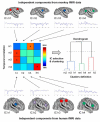
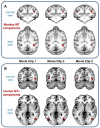

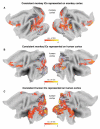
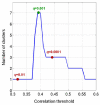
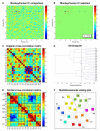
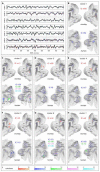

Similar articles
-
Interspecies activity correlations reveal functional correspondence between monkey and human brain areas.Nat Methods. 2012 Feb 5;9(3):277-82. doi: 10.1038/nmeth.1868. Nat Methods. 2012. PMID: 22306809 Free PMC article.
-
Sensory processing during viewing of cinematographic material: computational modeling and functional neuroimaging.Neuroimage. 2013 Feb 15;67:213-26. doi: 10.1016/j.neuroimage.2012.11.031. Epub 2012 Nov 29. Neuroimage. 2013. PMID: 23202431 Free PMC article.
-
Evolutionarily novel functional networks in the human brain?J Neurosci. 2013 Feb 20;33(8):3259-75. doi: 10.1523/JNEUROSCI.4392-12.2013. J Neurosci. 2013. PMID: 23426655 Free PMC article.
-
The chronoarchitecture of the cerebral cortex.Philos Trans R Soc Lond B Biol Sci. 2005 Apr 29;360(1456):733-50. doi: 10.1098/rstb.2005.1627. Philos Trans R Soc Lond B Biol Sci. 2005. PMID: 15937010 Free PMC article. Review.
-
Human cortical areas underlying the perception of optic flow: brain imaging studies.Int Rev Neurobiol. 2000;44:269-92. doi: 10.1016/s0074-7742(08)60746-1. Int Rev Neurobiol. 2000. PMID: 10605650 Review.
Cited by
-
Common functional localizers to enhance NHP & cross-species neuroscience imaging research.Neuroimage. 2021 Aug 15;237:118203. doi: 10.1016/j.neuroimage.2021.118203. Epub 2021 May 25. Neuroimage. 2021. PMID: 34048898 Free PMC article.
-
Representation of the material properties of objects in the visual cortex of nonhuman primates.J Neurosci. 2014 Feb 12;34(7):2660-73. doi: 10.1523/JNEUROSCI.2593-13.2014. J Neurosci. 2014. PMID: 24523555 Free PMC article.
-
Minimal specifications for non-human primate MRI: Challenges in standardizing and harmonizing data collection.Neuroimage. 2021 Aug 1;236:118082. doi: 10.1016/j.neuroimage.2021.118082. Epub 2021 Apr 18. Neuroimage. 2021. PMID: 33882349 Free PMC article.
-
Comparative connectomics of the primate social brain.Neuroimage. 2021 Dec 15;245:118693. doi: 10.1016/j.neuroimage.2021.118693. Epub 2021 Oct 31. Neuroimage. 2021. PMID: 34732327 Free PMC article. Review.
-
A ventral salience network in the macaque brain.Neuroimage. 2016 May 15;132:190-197. doi: 10.1016/j.neuroimage.2016.02.029. Epub 2016 Feb 17. Neuroimage. 2016. PMID: 26899785 Free PMC article.
References
-
- Anderson ML. Neural reuse: a fundamental organizational principle of the brain. Behav.Brain Sci. 2010;33:245–266. - PubMed
-
- Bartels A, Zeki S, Logothetis NK. Natural vision reveals regional specialization to local motion and to contrast-invariant, global flow in the human brain. Cereb.Cortex. 2008;18:705–717. - PubMed
-
- Beauchemin SS, Barron JL. The computation of optical flow. ACM Computing Surveys (CSUR) 1995;27:433–466.
Publication types
MeSH terms
Grants and funding
LinkOut - more resources
Full Text Sources
Miscellaneous

